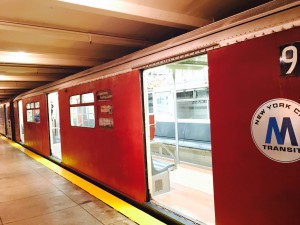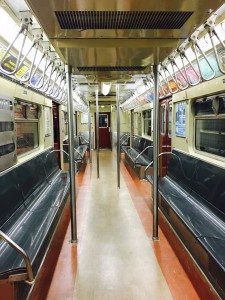i think the video on Penn station was very informing. I was amazed to see that Penn station was once the 4th largest building and the original building was tall with high ceiling and spectacular lighting. I could imagine how much of a hassle it was to travel on the boat from Pennsylvania on the Hudson river and with the mass chaos going on in the water that bought on stress to the people. It is sad that in the words of Vincent Skully” The city once was looked at as a God now looked in as a rat”. I think its ashamed that the Vanderbilt family felt they needed to out do Alexander Cozad and build their building more grand and made Penn station look like trash. In my opinion i think Penn Station should’ve of been more grand today because it is just as important and has history like Grand central terminal.
Category Archives: Uncategorized
Wilgus papers reflection
The wilgus papers collection is a source that is way more than useful it is quite integral when doing research on Grand Central Terminal and electrification. Prior to reveiwing this collection, I was wondering where I would find research sources on GCT and its tradition into the electric world but with this collection, it has mad researching this topic quite simpler. Now the use of the key terms and subjects as an organizing tool is quite effective and also makes finding specific research sources quite easy. This tool is very useful, I would recommend this to anyone who wants to do research on GCT and its magnificent architecture and engineering.
Wilgus Papers
Looking at the William J Wilgus Papers really makes me appreciate the “finding aid” tool since it encapsulates the entirety of the collection in a single neat and organized source. The papers are extensive, and if they were not organized, I shudder to think of the intray of the person who would be interested in Wilgus’ life.
As the Wilgus papers are extensive, and one can see the sheer amount of data that is present- the finding aid acts as a type of organizer for the documents, and makes each section (and subsection) easier to access and browse through. To me a finding aid is kind of like tabs in a binder- each tab represents a portion of data that is relevant to that sub heading. Finding aids are also more than just subsections- they also summarize the entire collection (which in Wilgus’ case was very helpful since I found reading his entire bio very daunting), where the collection came from (collection overview), biographical information, the scope and arrangement of the collection (most useful for research since this shows where to go when looking for specific topics or specific years), administrative information (which shows where the collection is located at), key terms (which help in finding this collection for researchers), and using the collection (the physical location of the collection and how to get your hands on it).
Finding aids are metadata on the data that is being researched. It is the information that makes researching easier to understand and easier to browse through in order to find the specific information that you need to write your paper or report, etc. William Wilgus seemed like an extremely interesting person with a lively and demanding architectural career (which I gleaned by browsing just the detailed description of the collection!)
Library Book: Grand Central Terminal: Gateway to a Million Lives
I was unaware before that we were supposed to add our library book’s contents on openlab (I had it in my notebook):
“Grand Central Terminal: Gateway to a Million Lives:”
This book talks about the history of how GCT came to be. It talks about before the construction of GCT, during the process of GCT being constructed, and then how GCT grew and declined. The book also goes over the restoration of GCT and the beginning of the 21st century for GCT. It is a good source for someone wishing to understand how GCT was influenced throughout time.
Table of Contents:
I. Saving an archetype
II. Life before the terminal
III.How Grand Central became grand
IV. Real Estate and train travel
V. Home to the Nation
VI. Grand Central of the imagination
VII. The decline of Grand Central
VIII. The Restoration Cast Assembles
IX. Grand Central is Reborn
X. Grand Central as a bazaar
XI. Into the 21st Century
Transit Museum Reflection
Growing up as a kid, I remember the bright red 90s trains that would clickety clack their way through the city. Going to the transit museum was worth just being able to see those trains again, and being able to sit in them. It was also very interesting to be able to see the older version of trains- and it felt as though the older the train got, the more comfortable the seats became!
Another thing that really caught my attention at the transit museum was the different types of tokens that were used as forms of payment. For one thing, I always believed that metro cards were used far longer (early 90s at least) than they actually were (started being used in 2000s), and was surprised that up till 1995 tokens were used for the trains (I don’t remember tokens for the trains perhaps since I never had to buy them myself at that age). One of the other interesting parts of the museum that caught my attention was this mounted plaque with things called slugs- that were counterfeit tokens so that people could get past the turnstiles without paying. I thought it was extremely interesting and funny that the MTA had a copy of each type of counterfeit token for the ages.
GCT 100 year Panel Video
The PBS panel video on GCT’s 100 year anniversary was.. interesting. There were a lot of facts and figures, which I guess one would expect since every person there was an expert of some form that related to GCT. I wasn’t really as vested in this video compared to some of the others that we as a class watched- perhaps this was a little too cut and dry for me.
One of things that I did find to be interesting was how much Penn Station cropped up in the conversation- which yes, of course I knew it would be mentioned at some point- but I felt as though while some of the panel members thought that it was a shame that Penn Station was destroyed, others thought it was more of a stand alone building and the destruction of it was inevitable, while GCT had more going for it, which is why it still stands today. This I can understand, since I know that GCT has its own income that stems from the retail space that businesses inhabit in and GCT.
I think if we were to have watched this video as an introduction to GCT it would have peaked more interest- but since we already ventured in detail about GCT, getting a skimmed version of it wasn’t very captivating.
Penn Station Video Reflection
“Penn Station is a martyr that enabled Grand Central Terminal to be saved.”
This was probably the most frustrating line that the video talked about. I don’t believe that Penn Station was a martyr, because I see Penn Station as a victim. A victim to New Yorker’s ignorance of understanding the necessity to hold on to buildings that preserve history. I believe that we as New Yorkers are so keen and happy with the future, since we are always the first to every new gadget and gizmo on the market, that we forget what it means to preserve New York- that we as a city have our own history. The destruction of Penn Station isn’t JUST about the building; its about a beautiful piece of our history (the history of the effort of thousands of New Yorkers who put their sweat, blood, tears, and lives for the creation of Penn Station) that was allowed to be destroyed for capital, profit, and the “bottom line.” The most powerful emotion that passed through me while watching the video was when the actual pieces of Penn Station were being removed and the last shot of them lying a thither abandoned in some waste in NJ. Professor Philip’s reaction in our last GCT tour became crystal clear to me- when she was outraged that a hotel from Terminal City was being torn down to be replaced by a 70 story skyscraper- I completely understand your anguish Professor!
The video as a whole was extremely interesting, and I felt as though the video was very informative but also emotional in the sense that the struggle of bringing Penn Station to life was that of not only Alexander Cassatt, but numerous other workers, from engineers to the sandhogs who carefully and dutifully gave us Penn Station.
I believe that this video will haunt me every time I pass through 34th street, whether on the train or on foot or on car. Every time I hear “This is 34th Street Penn Station; transfer to the 3, …, and Amtrak” the footage of Penn Station being built, how the sheer enormity of its building was awe inspiring, and the destruction and waste of Penn Station will flash before my eyes. oh the heartache!
GST video Reflection
Although the information that was shared in the panel of historians and architectures was repetitive information that we had already learned in class, it was interesting to see how in depth one can go when discussing grand central. One interesting idea that they brought up was the comparison between Penn Station and GST. They argued that Penn station was a standalone building as appose to GST which contained shops or as they stated a choreography of connection. They also debated on how Penn station was a necessary evil for the preservation movement to rise; thus thanks to Penn station we now have GST and other landmarks.
Penn Station Reflection
Up until this class I never new Penn station was such a monstrous building. Inspired again by the beaux-arts Mckim truly designed a building that was meant for a great metropolitan city. We see the vast entrance which he borrow from the Roman’s Baths of Caracalla after his visit there and sadly he never got the chance to see his work completed as he died before completion.
Although Penn station in it of itself was a momentous structure the infrastructure it laid was astonishing. We saw how with great precision and engineering the vision that a tunnel under the Hudson river was built. Sandhogs risk their lives and devoted many hours for cheap labor constructing the tunnel.
It was very disturbing watching the demolition crew bring down the station. I can see now how people can grow such emotional connections to something like a building.
Reflection on the Rise & Fall of Penn Station video
Penn Station was definitely a structure of grandeur, through this video it shows the stations beauty and at the same time it showed the ordeal it took t o get this station up in the air. Cassatt took the inspiration from the stations of Europe in regards to their electric trains that travel through long tunnels and causing little discomfort to its customers. Now Penn Station was great and in it creation, there succeeded the connection of their tracks in jersey to NYC and the connection of their newly acquired train line in Long Island (LIRR). So now, the question is why did GCT survive over Penn Station, I believe it dealt with the innovation of GCT’s architecture, its importance to its surrounding neighborhood, its pinnacle use in US history. But one of the major factors that helped save GCT was the destruction of Penn Station itself. New Yorkers truly realized what they had lost when Penn Station and so did a large portion of the nation and through this loss so many came together to fight for the cause of saving GCT and in result causing the formulation of NYC Landmark Preservation Commission. Penn Station lacked a large support from NYC citizens and the support from major celebrities, which GCT had and it was along with these two factors that helped propel its salvation forward. There also lies one more factor that differed between Penn Station and GCT and that was the fact that GCT had sub-connections to many of the surrounding buildings which allowed commuters/tourists to feel like they were in a city within a city (known as Terminal City).






